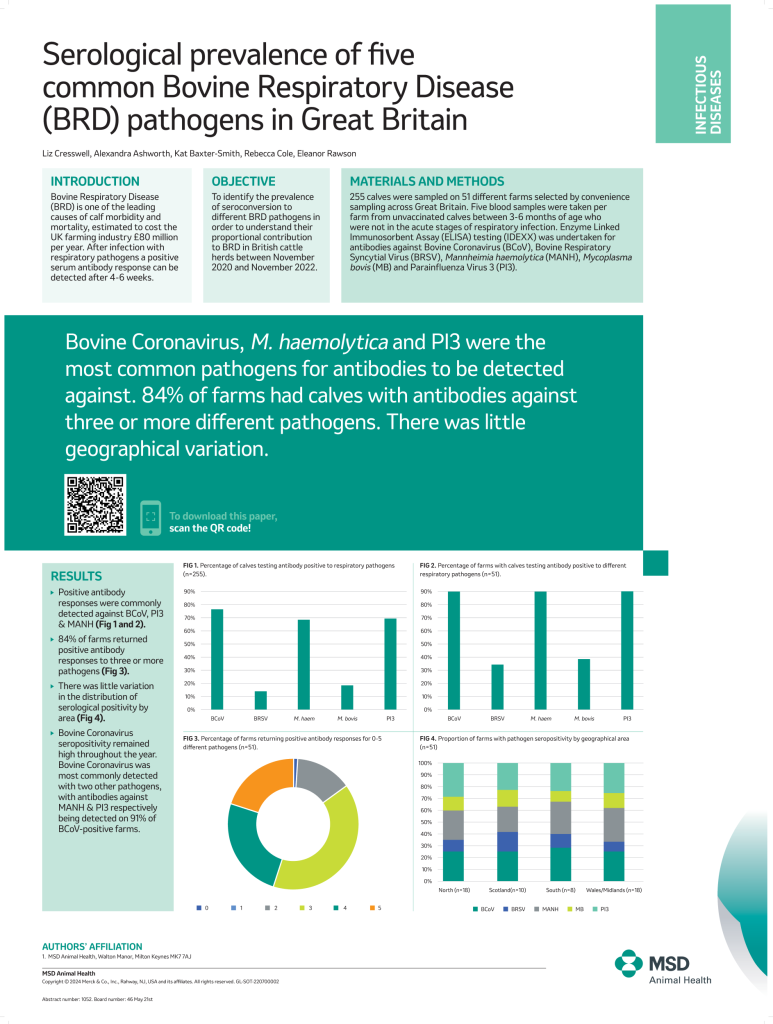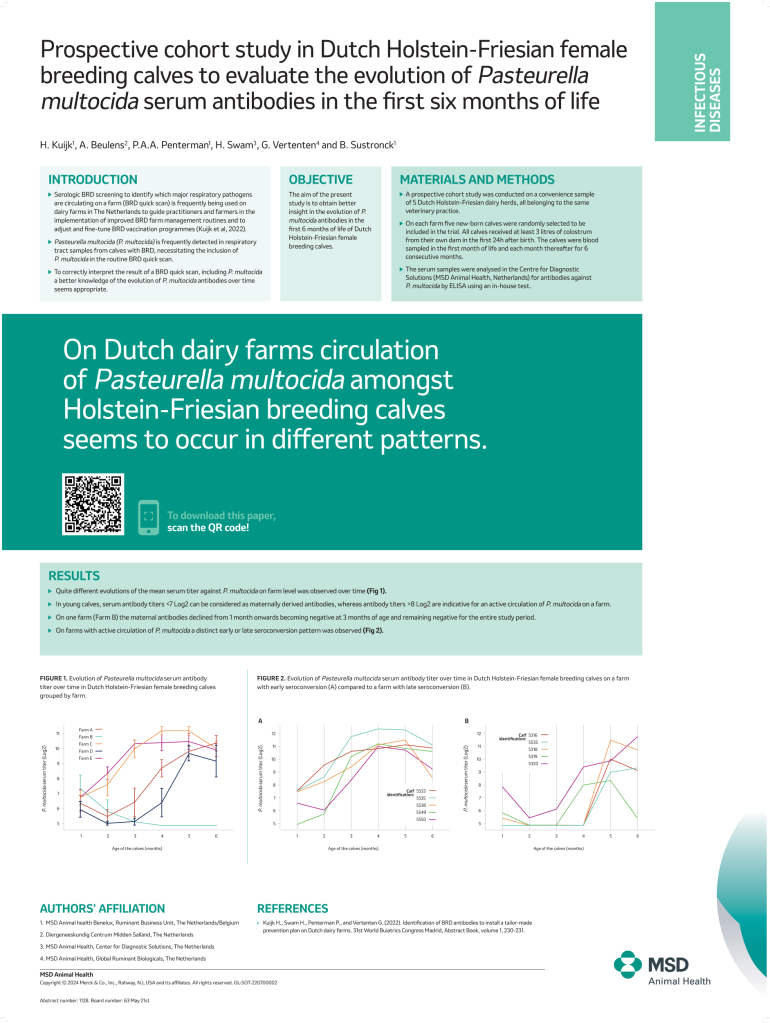Infectious Diseases
Main bovine respiratory infectious agents identified on stethoscopes and boots from 12 rural veterinary clinics.
Geert Vertenten1, Camille Levesque2, Thibault Jozan3
Swabs from stethoscopes and boots are frequently contaminated
with BRD agents (genetic material) as identified by PCR. Oma et al. 2018 showed that BCoV and BRSV could remain infectious
on this type of medium (at least 24h for BCoV). The risk of indirect transmission of respiratory agents by material and human vectors should be integrated in farm biosecurity.

Seropravalence of BRD pathogens on Dutch dairy farms: is bovine coronavirus involved?
H. Kuijk1, P.A.A. Penterman1, H. Swam2, G. Vertenten3 and B. Sustronck1
Bovine coronavirus can be considered as a major respiratory pathogen on BRD problem farms in The Netherlands.
In 89% of the BRD problem herds BCoV seropositive calves were detected and nearly 50% of those calves showed evidence of a recent contact with the virus.
On Dutch dairy farms with BRD problems Mycoplasma bovis seems to be of minor importance

Intranasal vaccination of calves from birth onwards: duration of nasal vaccine virus shedding
H. Kuijk1, L. Gille1, G. Hoflack1, P.A.A. Penterman1, H. Swam2, G. Vertenten3 and B. Sustronck1
Intranasal vaccination resulted in PI3 vaccine strain excretion in nasopharyngeal secretions for maximum 2 weeks.
BRSV and BCoV vaccine strains were not detected in nasopharyngeal secretions from one week after intranasal vaccination onwards.
One month after intranasal vaccination no vaccine strains were detected in BAL samples

Intranasal vaccination of calves at day of birth with a live attenduated vaccine against BRSV and BPIV3 and a live attenuated vaccine against respiratory coronavirus
Mark H. van Rooij 1, Mélodie Schmitz 2, Joris M.H. Meessen 1, Pieter A.W.M. Wouters 1, Mieke P. Vrijenhoek 1, Birgit Makoschey1, Geert Vertenten1, Klaas Okkinga3
Vaccination of calves at day of birth:
– No noteworthy adverse events
– Protective immune response against BRSV, BPIV3 and BCoV challenge
– Lower clinical scorings
– Significantly reduced amount of viral RNA in swab samples

Serological prevalence of five common Bovine Respiratory Disease (BRD) pathogens in Great Britain
Liz Cresswell, Alexandra Ashworth, Kat Baxter-Smith, Rebecca Cole, Eleanor Rawson
Bovine Coronavirus, M. haemolytica and PI3 were the most common pathogens for antibodies to be detected against. 84% of farms had calves with antibodies against three or more different pathogens. There was little geographical variation.

Bovine brucellosis: Advantages of using vaccine Brucella abortus RB51
Luis Samartino1,2, Pablo Martino3, Josué Lorenzatti1, Geert Vertenten4
Bovilis RB51 vaccine is an excellent tool to control bovine brucellosis since it didn’t interfere with B. abortus diagnostic results or induce abortion in pregnant animals previously vaccinated with B. abortus vaccines.

Retrospective study of the relative frequency of cattle respiratory disease pathogens from clinical laboratory samples submitted by UK veterinary practices
Katharine Denholm1, Neil P. Evans1, Katharine Baxter-Smith2, Paul Burr3
The majority of clinical bovine respiratory disease samples in the UK are multipathogenic. Bovine coronavirus has generally not been considered a significant contributing pathogen in the BRD complex in the UK (despite a growing body of evidence worldwide demonstrating both its presence and clinical importance in the syndrome). Warmer months and increasing age (in weeks) were significantly associated with a lower number of total pathogens identified from clinical bovine respiratory disease samples.

Long-term analysis of maternal bovine coronavirus antibodies: a prospective cohort study in Dutch Holstein-Friesian female breeding calves
H. Kuijk1, M. Bakker2, P.A.A. Penterman1, H. Swam3, G. Vertenten4 and B. Sustronck1
Active BCoV circulation amongst breeding calves on Dutch
dairy farms can be monitored by antibody screening from
3 months of age onwards. This can be helpful to justify the
implementation of a BCoV vaccination plan at young age.

Combining sampling techniques increases detection of carriers of Mycoplasma bovis
Linde Gille1, Julien Evrard2, Laurent Delooz2, Fabien Grégoire2, Geert Vertenten3
The detection of M. bovis carriers by PCR is increased if animals are tested in parallel in different sites, at least the nasal opening and the genital opening should be sampled. No semen tested positive for M. bovis in this study.
Furthermore, 8 out of 13 (62%) positive animals were only positive in a single nasal opening. As such, it is highly recommended that both nasal openings are swabbed when trying to identify M. bovis carriers.

A field study to determine equivalence of administering a live commercial BRSV/PI-3 intranasal vaccine to MDA+ve calves at Day 0 of life compared to 1 week of age
Kat Baxter-Smith1, Richard Cooper2, Graham Baird2, Jude Roberts2, Geert Vertenten3, Egon Thesing4
Vaccinating MDA-positive calves on commercial UK dairy farms
with a licensed BRSV/PI-3 vaccine [Bovilis INtranasal RSP Live]
on the day of birth is equivalent in terms of morbidity, mortality and weight gain to vaccinating at 7 days of age. This gives producers the confidence to vaccinate the calf from birth, knowing there is no interference from MDA.

Efficacy of a live bovine herpesvirus type 1 marker vaccine under field conditions through total herd vaccination
Clara Bourel1, Geert Vertenten1, André Preto1
Total herd vaccination with a live IBR marker vaccine
including culling of the infected animals, resulted in
the eradication of BHV-1 under field conditions in a
herd that has been infected for years.

Assessment of Pathogen Prevalence Frequency Associated with Bovine Respiratory Disease (BRD) in Mexican Dairy Heifers Using the Technique of Polymerase Chain Reaction (PCR)
Chapula Marco A.¹, Arreola Val D.², Echevarria Ponce R.³, Rodriguez P.4 , García Escalera A.¹
Pasteurella multocida, Mannheimia haemolytica, Mycoplasma bovis, and bovine coronavirus are the main pathogens associated with Bovine Respiratory Disease (BRD) in this study. These findings justify the implementation of health preventive programs in Mexican dairy farms to reduce economic losses due to BRD.

Assessment of Vaccine Interference Following Co-Administration of Two Modified-Live Viral Intranasal Vaccines to Colostrum-Fed Neonatal Calves with a Subsequent BHV-1 (BR) Challenge
1Michael W. Bolton, 1Scott Nordstrom, 1Kevin Hill, 1Lowell T. Midla, 2Philip J. Griebel, 2Karthic Rajamanikam, 3Geert Vertenten
Intranasal Modified Live vaccines N3 (BHV-1+PI3+ BRSV) and BCV, can be co-administered to neonatal calves without a significant decrease in the immunogenicity or a reduction in the prevention of BHV-1 respiratory infection and disease. The BCV vaccine alone unexpectedly had a significant protective effect against total lung pathology after a BHV-1 challenge.

Unexpected diarrhoea in adult cows can be caused by bovine coronavirus and needs proper feed management measures: a case report.
B. Hietberg1, H. Kuijk2, F. Waldeck3, G. Vertenten4 and B. Sustronck2
Bovine coronavirus is a possible cause of diarrhea and milk drop in dairy cows. On farms where the concentrate allowance is automatically linked to the milk production level of the cows, it is recommended to adjust the concentrate allowance manually to avoid prolonged production losses after cessation of the clinical symptoms. Mandatory systematic BHV1 whole herd vaccination contributes to becoming BHV1 free.

Effectiveness of brucellosis control using the RB51 vaccine in adult beef cows
Carlos Fernandes1,2, João Viana3, Ana Cristina Figueiredo2, Gustavo Pereira2, João Drumond4, Henderson Ayres4 , Lais Vieira4, Denis Antônio4, Geert Vertenten5, Luis Ernesto Samartino6
Vaccination with a single dose of RB51 in adult beef cows, previously vaccinated with S19, reduces the occurrence of new cases of brucellosis and the spread of the disease. Additionally, vaccination improves the reproductive performance of immunized cows.

Prospective cohort study in Dutch Holstein-Friesian female breeding calves to evaluate the evolution of Pasteurella multocida serum antibodies in the first six months of life
H. Kuijk1, A. Beulens2, P.A.A. Penterman1, H. Swam3, G. Vertenten4 and B. Sustronck1
On Dutch dairy farms circulation of Pasteurella multocida amongst Holstein-Friesian breeding calves seems to occur in different patterns.

Prevalence, Biosecurity and Risk Management of Bovine Coronavirus Infections in Valves on Dairy Farms in Europe
Anna Catharina Berge1 and Geert Vertenten2
BCoV is commonly present in both the respiratory and enteric pathway in neonatal calves, weaned calves and fresh cows in EU dairies, with all herds being seropositive to the virus, and the virus present in 80% of herds. Reduced shedding of virus was observed in neonatal calves that received colostrum from cows vaccinated against BoCV at the end of the gestation. No such effect was observed in weaned calves.

Emergence of Bovine Coronavirus as the Predominant Viral Respiratory Pathogen Detected by PCR in Cattle from Portugal
Vertenten, G1.; Teixeira, A.2; Pereira, A.3
Our findings confirm the presence of BCoV, PIV-3
and BRSV in cattle populations in Portugal from 2019 to 2022. Notably, BCoV was more frequently identified through PCR than other respiratory viral pathogen
from 2020 to 2022.

Comparative response of two single dose vaccines for controlling neonatal calf diarrhea in beef cattle
Bejar JP1, Piñeiro, P2, Vicente MI2, Fraile L3 and Elvira L2
As previously shown in dairy, a positive impact of vaccination in beef cows, and a more complete and balanced specific immune response against the three pathogens in the group vaccinated with Bovilis® Rotavec® Corona compared to the group vaccinated with Bovisan® Diar / Bovigen® was found.

Mucosal and Systemic Immune Responses Following Intranasal Vaccination of Holstein Heifer Calves With Either a Bivalent Modified-Live Bacterial Vaccine or a Vaccine Containing the Same Bacteria and Three Modified-Live Viruses
Guy Boisclair1; Philip Griebel2
The current study confirmed that both the Once PMH®-IN
and Bovilis® Nasalgen® 3-PMH vaccines are immunogenic in young calves. There were no significant differences when comparing the local IgA antibody and systemic T lymphocyte responses induced by the bacterial components of these two vaccines.

Comprehensive who genomic analysis of Escherichia coli and Salmonella spp. isolates in neonatal diarrhea among calves from Latin America Industrial Dairy Farms
Luis León Paredes1, Diego Flores1, Sofía Zamudio1, Karen Mujica1, Pabla Lara1, Nelson Garrido1, Rodrigo Norambuena1, Victoria Rojas-Martínez1, Andrea Sabag1, María Jesús Serrano1, Michael Pino1 , Paola Mora1, Valeria Salgado1, Daniel Tichy1, Pamela Camejo1, Néstor Roca1, Pablo Cifuentes1, Soledad Ulloa1, Nicolás Cifuentes1, Geert Vertenten2, José García2, Vanessa Masson2, Guillermo Gargantini2, Marco Gallardo2, Felipe De La Fuente2
There is a high E. coli diversity (20-49 serovars) and low Salmonella spp. prevalence (9%) across the different dairy farms in Latin America. All isolates had pathogenic mechanisms to generate diarrhea in calves. 86% of E. coli isolates and 100% of Salmonella isolates were resistant or multi-resistant to antimicrobials.


